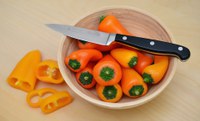Prairie Fare: Hot and Mild Peppers Add Flavor and Nutrition
(Click an image below to view a high-resolution image that can be downloaded)
“This needs something,” my older daughter said as she dipped a tasting spoon into the marinara sauce.
I had roasted the last of the tomatoes from the garden with garlic and olive oil. Then I seasoned it and blended it with an immersion blender.
“How about adding more balsamic vinegar?” I asked as I added some Italian seasoning.
She went to the cupboard and added something to the pot. She smirked at me as she quickly put the bottle back in the cupboard.
Then she started sneezing. I walked over to taste the contents of the updated bubbling pot on the stove. I began sneezing, too.
“Did you add a lot of pepper to the pot?” I asked between sneezes.
“I added some of my dried Demon Red chili pepper,” she admitted.
I was afraid to dip a spoon in the pot for fear it might melt or explode.
“Oh, Mom, I just added a tiny bit,” she said with a laugh and another sneeze.
The sauce was very good, actually, with just the right amount of heat but not too much for those of us with Scandinavian bloodlines.
Why are some peppers so spicy-hot to the point of inducing perspiration and pain? Hot peppers produce a burning sensation in your mouth because they contain a compound called capsaicin.
The heat in peppers can be measured in Scoville heat units, which is a measure of the capsaicin present. Wilbur Scoville, a chemist, developed the test for assessing the heat in chili peppers about 100 years ago.
Every year my daughter grows some kind of super-hot pepper plant in our garden. The dried pepper she added from last year has a rating of 50,000 on the Scoville scale. By comparison, a bell pepper measures zero.
This year she grew a ghost pepper plant, which has a Scoville heat unit rating of at least 750,000 heat units.
According to some scientists, we actually build up a tolerance to hot food and may crave it after a while. When we eat super-spicy food, the nervous system responds to the pain by releasing endorphins or “feel-good” chemicals.
To determine the Scoville units, dried peppers were crushed and added to a sugar-water solution. Then a panel of taste testers rated the heat level. More peppers were added until the testers could detect they were present.
His testers could handle tasting one hot pepper sample per day before their tongues needed a rest.
Peppers range in spiciness starting from zero, which is the number assigned to a sweet bell pepper. A jalapeno pepper has a Scoville rating of about 5,000, while serrano peppers have a rating of about 15,000 or more. If you really want to challenge your taste buds, try a habanero, which is known for its fiery, acidic heat and carries a rating above 350,000 Scoville units. Extremely hot peppers have values above 1 million Scoville units.
Thankfully, for human taste testers, lab equipment now can measure the capsaicin level in various types of peppers.
When you are handling hot peppers, keep in mind that the volatile oils can burn your skin. Wear plastic gloves to protect your hands and be careful not to touch your face or your eyes. Be sure to wash your hands thoroughly.
If you’re enjoying some spicy-hot food, be sure to have a glass of milk close at hand. The protein in milk helps counteract the burning sensation of the volatile oils in the peppers by encapsulating the oil and helping wash it away.
Peppers are low in calories and very rich sources of vitamin C and natural disease-fighting antioxidants. Green peppers will ripen to become red peppers, which are sweeter and higher in vitamin C.
One of my student interns brought this recipe for testing, and it was a hit. Tahini is sesame seed paste. Look for it in the condiments section or ethnic food section of larger stores.
Roasted Bell Pepper Hummus
2 whole red bell peppers
1 (15-ounce) can of chickpeas
¼ cup lemon juice
¼ cup tahini
1 garlic clove, minced
2 tablespoon extra virgin olive oil
½ teaspoon cumin
Pinch of cayenne
Salt to taste
Wash peppers, cut into quarters and scrape out the insides. Move the oven rack directly under broiler. Set peppers skin side up on baking sheet. Place baking sheet in the oven on the top rack. Set oven to broil and broil peppers for 5 to 10 minutes, until skin is charred. Let peppers cool. Remove charred skin and chop, or leave skin on and chop. Blend tahini and lemon juice for 1 minute, scrape sides and blend for additional 30 seconds. Add olive oil, garlic, cumin and salt, blend for 30 seconds, scrape sides, and blend for another 30 seconds. Drain and rinse the can of chickpeas. Add half the chickpeas to a blender and blend for 1 minute. Scrape sides and add the other half of the chickpeas. Blend for 1 to 2 minutes. Scrape sides. Add peppers and blend until smooth. If hummus is too thick, add some water. If hummus is too thin, blend in additional chickpeas. Serve with carrot sticks, celery sticks, pepper sticks, crackers, pita chips, etc.
Makes eight servings. Each serving has 130 calories, 8 grams (g) fat, 4 g protein, 11 g carbohydrate, 3 g fiber and 85 milligrams sodium (without added salt).
(Julie Garden-Robinson, Ph.D., R.D., L.R.D., is a North Dakota State University Extension food and nutrition specialist and professor in the Department of Health, Nutrition and Exercise Sciences. Follow her on Twitter @jgardenrobinson)
NDSU Agriculture Communication – Sept. 30, 2021
Source: Julie Garden-Robinson, 701-231-7187, julie.garden-robinson@ndsu.edu
Editor: Elizabeth Cronin, 701-231-2721, elizabeth.cronin@ndsu.edu




